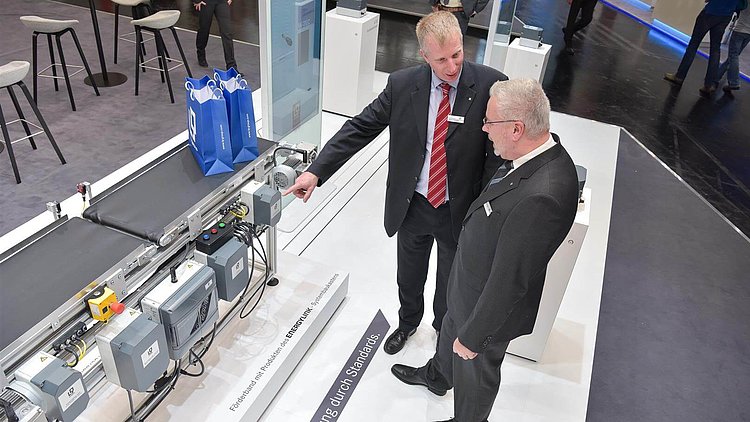
Time and cost savings of up to 80 percent
The control and installation technology for mechanical and plant engineering is much easier to implement, even in the project planning stage, thanks to LQ Mechatronik-Systeme's system configurator. This saves an enormous amount of time and money for project planning, even before the actual process for purchasing electromechanical parts has begun.
Configuration is becoming a trend. Configurators that allow everyday products to be personalised attract customers in nearly all sectors of the consumer goods industry. When it comes to capital goods such as plant and machinery, there are product configurators but, possibly more significantly, system configurators as well, which have potential to deliver considerable advantages in times of outsourcing and when there is a shortage of skilled workers. "However, many of these system configurators use the same structures as product configurators and these do not come into play until the order process, where the huge number of different variants and options cause confusion," explains José Quero, LQ Mechatronik-Systeme's Managing Director.
Adjusted range – attractive prices
The LQ Group has for many years set itself the goal of simplifying electromechanical assemblies and has set standards using its own products such as X-TEC circular plug-in connectors and cables from the X-TEC series. In the A-TEC modules the company delivers standard functions that perform their tasks directly on the machine. The control and installation technology for mechanical and plant engineering is much easier to implement, even in the project planning stage, thanks to LQ Mechatronik-Systeme's system configurator. This saves an enormous amount of time and money for project planning, even before the actual process for purchasing electromechanical parts has begun. He and his team saw a genuine reduction in workload during the project planning and procurement process for electromechanical components where parts lists and circuit diagrams have to be defined even before the order is placed. The use of a standardised modular product system limits the selection of suitable components where this is required. An end-to-end concept ensures that interface problems are excluded right from the start. Apart from LQ's products in the EnergyLINK modular system, the configurator also accesses partners' functions. This makes it possible to map the electromechanical equipment in its entirety whilst retaining the necessary flexibility.
"Also, our system can be used without the operator having in-depth specialist knowledge. This is an advantage that should not be underestimated in times when there is a shortage of skilled workers," he adds. Starting with the actuator/sensor as a basis, the configurator calculates suitable functions independently, maps the installation plan and compiles the parts list. To do this, the configurator uses the standardised products from the EnergyLINK modular system. "It is only by applying this automation that we can actually make these enormous savings of 80 percent across the whole process with project planning for the electrical equipment and also assured quality." The deployment of complete systems definitely offers more potential for savings than the continuous search for an individual product which is thought to be cheaper but the attraction of which is diminished when the costs are viewed over the whole value chain.
Outsourcing electrical automation
The trend in mechanical and plant engineering to concentrate on core expertise has continued for many years now. It makes sense for the majority of manufacturers in the mechanical and plant engineering sector to outsource electrical automation. "It is only logical for our customers to use system configurators now and to get them to handle the high-cost tasks of project planning and the production of circuit diagrams and parts lists, instead of the time-consuming task of sourcing suppliers, cables and plugs," admits Hermann Engber, Head of Development. Data is transferred to the online shop via a digitised interface: this is simple and clear to operate and is similar to the system configurator. The functions from the parts list are stored in the shopping basket and can be ordered at the click of a mouse.
The system configurator in practice
Taking the consumer (actuator/sensor) and its functions as a basis, the system configurator defines the required components independently from the tried-and-tested LQ EnergyLINK module. Interface problems relating to the products stored there are no longer relevant because of the use of standards. Everything fits together perfectly. "Customers log on and enter the actuators and sensors at the lowest level. They provide more details, stating the current intensity, voltage or criteria such as a soft start or on/off. As an alternative, existing parts lists can be imported with the corresponding information," Engber explains. The configurator then takes the appropriate functions from the EnergyLINK modular system. Logical assemblies can be grouped together in a structured way. He adds: "This creates a clear and orderly structure, which can ultimately be shown using an appealing layout with associated parts lists."
The advantages at a glance
The system configurator makes it very much easier to structure the control and installation technology, right from the development stage. Instead of deploying expensive skilled staff to look for cables, plugs and assemblies, it takes just a few clicks to produce a complete system. The parts purchasing team also have a reduced workload, as they no longer need to check different variants from various manufacturers. There is less work in the warehouse, because the company buys in precisely what it requires and no large fixed quantities have to be purchased, which then only end up sitting in the stores. Finally, it pleases the logistics department, because the finished system is delivered conveniently to the production line. If a service incident occurs, LQ's experts look after the products and they have the specific know-how to ensure that the control and installation technology functions correctly.
In the future, too, the system configurator will thrive by continuously adapting to market requirements. José Quero: "We expand our engineering knowledge every day and use it to enhance our modular system, which provides the information for the configurator."